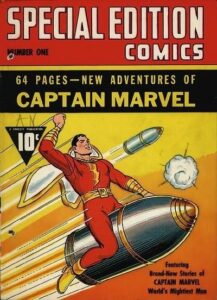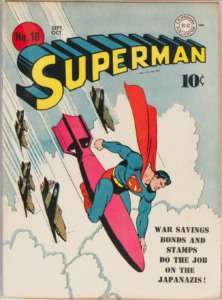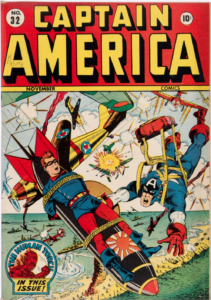We recently added themes to Comics Price Guide to help collectors organize different subsets within their collection like kissing covers or Marvel Value stamps. What we didn’t realize was the size and scope of the rabbit hole we created. Some themes are easy to assemble like the 22 different Robot Chicken covers DC created in 2014. Easy. Other themes require diving head-first into the rabbit hole like an Olympic athlete who eats only kale and spinach smoothies spiked with performance-enhancing drugs. Not so easy.

Occasionally I’ll highlight one of the themes that needed more research or have some entertaining aspects, today’s theme is the Riding a Bomb cover. Sometimes this moves into riding rockets, missiles, and even fireworks but it always requires some suspension of reality. These projectiles are usually extremely smooth with nothing to grasp while rocketing through the atmosphere at warp speed. Not the most believable scenario ever crafted by comic book creators.
The basic way to view this theme is as a phallic symbol but that isn’t how it started, it was much more patriotic than that. The original Riding a Bomb cover in Special Edition Comics #1 was done by C.C. Beck, renowned for his work on early Fawcett issues. That one-shot was published in August 1940 more than a year before the United States would enter WWII. The second cover, Whiz Comics 14 was also created by C.C. Beck and featured Captain Marvel. Although this time he was riding a torpedo like a surfboard. Hang Ten Captain Marvel!
I’m not sure if Mystery Men Comics 27 counts as a bomb-riding cover since she isn’t airborne yet. This is the first cover to feature someone who isn’t choosing to ride a bomb instead she is being tied to a bomb. Some say this is why women live longer than me. Don’t worry, Blue Beetle is there to dispose of the Nazis.

We aren’t sure who the artist was for the third (or fourth) bomb riding cover Feature Comics 50 in November 1941 but it still predates the United States entering the war. World War II was a wildfire out of control so maybe comic book artists knew it was inevitable. Or perhaps they wanted the United States to enter the war for various reasons and this was their way to encourage it.
The first riding a bomb cover after the US entered WW II was Superman 18 in September 1942. With clear instructions to buy war bonds emblazed on the cover, this was an effort to help the war effort. Remember that this clear propaganda was directed at kids to help them see a fantasized view of war.
National Comics 30 from 3/1943 is one of the most obvious patriotic bomb riding covers. Uncle Sam isn’t holding on to anything unless he has very powerful and grippy glutes. He is happily riding a bomb to his demise while also endangering a child who seems to be thrilled to die as well. To me, this is the cover that inspired the Dr. Strangelove movie in the 1960s.

All 15 Riding a bomb covers from the 1940s show very little of the chaos and devastation of a real war. The notable exception is Captain America Comics 32 which does show some explosions and chaos. That Syd Shores cover is by far the most realistic from that era.
After the war ended riding a bomb covers became less prevalent as the United States focused on getting back to work. In more recent days someone jumping onboard and riding a bomb like a bucking bronco happens much less frequently. For those of you wanting to see the most obvious phallic bomb riding covers take a look at Master Comics 120 or Wonder Woman 205.
As we continue to add new themes and research covers that showcase that theme we will be adding new bigger scans. Who doesn’t love a larger scan? To see a full list of all Riding a Bomb comic book covers
by Ron Cloer
Source: Comics Price Guide

